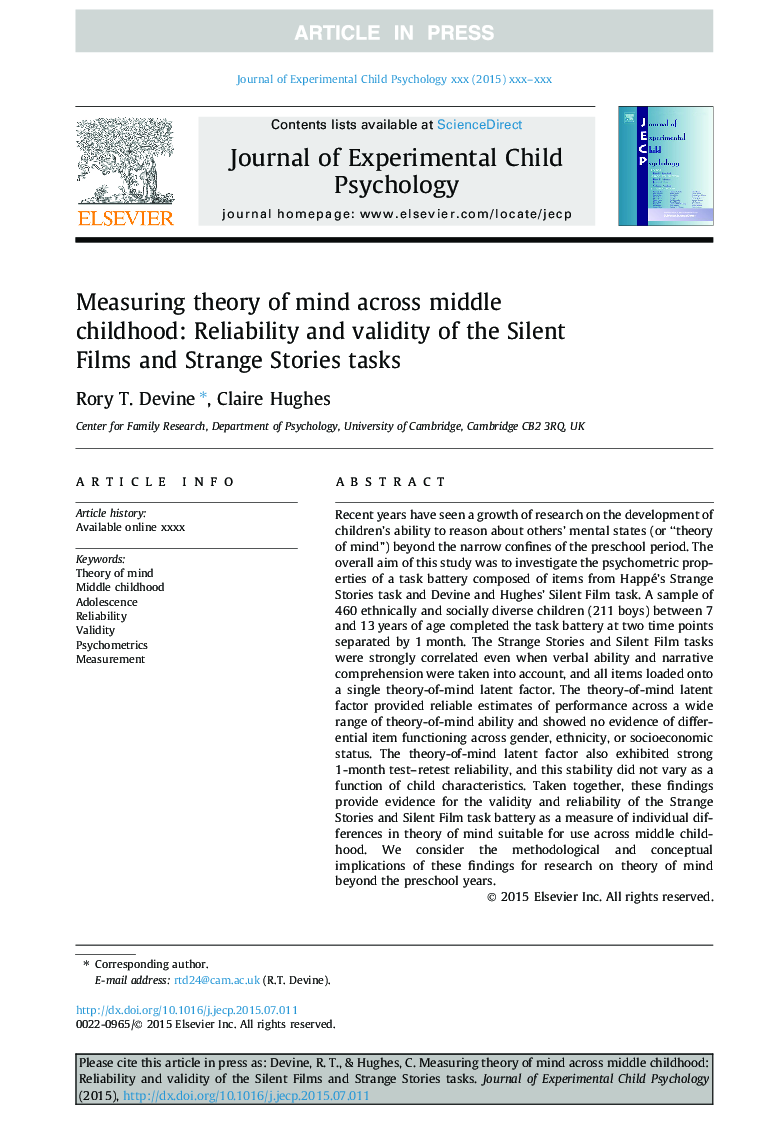| کد مقاله | کد نشریه | سال انتشار | مقاله انگلیسی | نسخه تمام متن |
|---|---|---|---|---|
| 7274597 | 1473463 | 2016 | 18 صفحه PDF | دانلود رایگان |
عنوان انگلیسی مقاله ISI
Measuring theory of mind across middle childhood: Reliability and validity of the Silent Films and Strange Stories tasks
ترجمه فارسی عنوان
نظریه اندازه گیری نظریه ذهن در دوران کودکی متوسط: قابلیت اطمینان و اعتبار فیلم های خاموش و داستان های عجیب و غریب
دانلود مقاله + سفارش ترجمه
دانلود مقاله ISI انگلیسی
رایگان برای ایرانیان
کلمات کلیدی
نظریه ذهن، دوران کودکی، بلوغ، قابلیت اطمینان، اعتبار، روان سنجی، اندازه گیری،
موضوعات مرتبط
علوم انسانی و اجتماعی
روانشناسی
روانشناسی رشد و آموزشی
چکیده انگلیسی
Recent years have seen a growth of research on the development of children's ability to reason about others' mental states (or “theory of mind”) beyond the narrow confines of the preschool period. The overall aim of this study was to investigate the psychometric properties of a task battery composed of items from Happé's Strange Stories task and Devine and Hughes' Silent Film task. A sample of 460 ethnically and socially diverse children (211 boys) between 7 and 13Â years of age completed the task battery at two time points separated by 1Â month. The Strange Stories and Silent Film tasks were strongly correlated even when verbal ability and narrative comprehension were taken into account, and all items loaded onto a single theory-of-mind latent factor. The theory-of-mind latent factor provided reliable estimates of performance across a wide range of theory-of-mind ability and showed no evidence of differential item functioning across gender, ethnicity, or socioeconomic status. The theory-of-mind latent factor also exhibited strong 1-month test-retest reliability, and this stability did not vary as a function of child characteristics. Taken together, these findings provide evidence for the validity and reliability of the Strange Stories and Silent Film task battery as a measure of individual differences in theory of mind suitable for use across middle childhood. We consider the methodological and conceptual implications of these findings for research on theory of mind beyond the preschool years.
ناشر
Database: Elsevier - ScienceDirect (ساینس دایرکت)
Journal: Journal of Experimental Child Psychology - Volume 149, September 2016, Pages 23-40
Journal: Journal of Experimental Child Psychology - Volume 149, September 2016, Pages 23-40
نویسندگان
Rory T. Devine, Claire Hughes,
